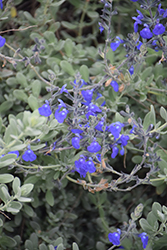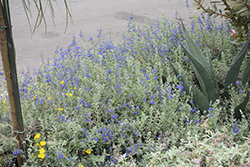Fri & Sat 8am - 8pm
Sun 8am - 7pm
Anytown, USA 12345
fax: 261.787.0463
e-mail: info@successgc.com


Plant Finder

Plant Height: 16 inches
Flower Height: 24 inches
Spacing: 3 feet
Sunlight:
![]()
Hardiness Zone: 8a
Other Names: Mexican Blue Sage
Description:
A low growing woody based perennial presenting a spreading mound of small, narrow, silvery-green leaves; brilliant royal blue flowers with wide lips appear from mid-spring to fall; great for sunny border fronts or as a small scale, water-wise groundcover
Ornamental Features
Germander Sage has masses of beautiful clusters of lightly-scented royal blue tubular flowers with violet overtones and a white blotch rising above the foliage from mid spring to mid fall, which emerge from distinctive indigo flower buds, and which are most effective when planted in groupings. The flowers are excellent for cutting. Its small tomentose narrow leaves remain grayish green in color with hints of silver throughout the year.
Landscape Attributes
Germander Sage is an herbaceous evergreen perennial with an upright spreading habit of growth. Its relatively fine texture sets it apart from other garden plants with less refined foliage.
This is a relatively low maintenance plant. Trim off the flower heads after they fade and die to encourage more blooms late into the season. It is a good choice for attracting bees, butterflies and hummingbirds to your yard, but is not particularly attractive to deer who tend to leave it alone in favor of tastier treats. Gardeners should be aware of the following characteristic(s) that may warrant special consideration;
- Insects
- Disease
Germander Sage is recommended for the following landscape applications;
- Mass Planting
- Border Edging
- General Garden Use
- Groundcover
- Naturalizing And Woodland Gardens
- Container Planting
Planting & Growing
Germander Sage will grow to be about 16 inches tall at maturity extending to 24 inches tall with the flowers, with a spread of 4 feet. When grown in masses or used as a bedding plant, individual plants should be spaced approximately 3 feet apart. It grows at a medium rate, and under ideal conditions can be expected to live for approximately 5 years. As an evegreen perennial, this plant will typically keep its form and foliage year-round.
This plant should only be grown in full sunlight. It is very adaptable to both dry and moist growing conditions, but will not tolerate any standing water. It is considered to be drought-tolerant, and thus makes an ideal choice for a low-water garden or xeriscape application. This plant does not require much in the way of fertilizing once established. It is not particular as to soil type or pH, and is able to handle environmental salt. It is somewhat tolerant of urban pollution. Consider applying a thick mulch around the root zone in winter to protect it in exposed locations or colder microclimates. This species is not originally from North America. It can be propagated by division.
Germander Sage is a fine choice for the garden, but it is also a good selection for planting in outdoor pots and containers. With its upright habit of growth, it is best suited for use as a 'thriller' in the 'spiller-thriller-filler' container combination; plant it near the center of the pot, surrounded by smaller plants and those that spill over the edges. Note that when growing plants in outdoor containers and baskets, they may require more frequent waterings than they would in the yard or garden.

